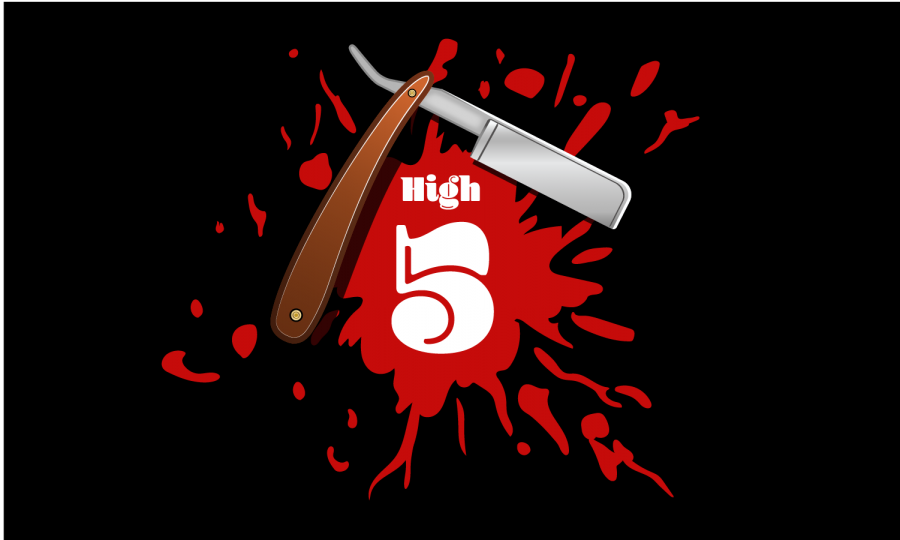High Five: The best giallo thrillers for Halloween
September 28, 2021
In the early ‘60s to late ‘80s Italy was a powerhouse for cinema. One genre often forgotten today is the giallo. Translated to “yellow”, they were inspired by pulp-mystery novels popularized in post-fascist Italy.
Giallo films blended murder-mystery with proto-slasher set-pieces and were known for their beautiful women, complex storylines, stunning visuals and overindulgent violence. Many directors, starting with Mario Bava in the early ‘60s, would uniquely contribute to what became giallo. Though it was phased out in the late ‘70s giallo continues to live on in many iconic horror films.
These are the five films that stand out to me as the best giallo gave us.
A Bay of Blood (1971)
Directed by Mario Bava, this sordid classic was a gamechanger for horror. Opening with eerie shots of the bay setting, the film begins when Countess Federica Donati is murdered by her husband in a staged suicide.
Her death sets off a chain reaction of brutal murders perpetrated by members of her family, all with unique motives. Each death becomes increasingly violent with standout gore effects by Carlo Rambaldi. Given the high body count and extreme violence it’s often considered the original slasher.
Due to its content the film was very controversial, going through various name changes to avoid censorship in the United Kingdom and Italy. It was harshly criticized for brutality uncharacteristic of Bava’s earlier works.
Despite initial controversy, its influence is far-reaching. “Friday the 13th Part II” directly lifts two murder scenes from this movie, the most iconic being where a couple is impaled in bed. It’s stalkerish direction style can be seen in other American horror films like “Halloween” (1978), particularly in its POV shots.
With extreme violence, amazing practical effects and a hilarious ending to boot this film stands out as the giallo that defined a generation of horror.
The Strange Vice of Mrs. Wardh (1971)
A razor-wielding sex maniac is on the loose in Vienna and Julie Wardh, a diplomat’s wife, believes her sadistic ex-lover Jean is to blame.
Also known as “Blade of the Ripper”, this is one of director Sergio Martino’s first giallo, and in my opinion, one of his best. Its strong story is carried by an even stronger cast, including the lovely Edwige Fenech, who fits into the role of Mrs. Wardh perfectly.
One aspect of this film that stood out to me is the suspenseful atmosphere. It’s a harrowing feature with tense relationship drama, an array of red herrings and terrifying kill scenes. It does a good job of portraying Wardh’s shame and paranoia as she’s forced to revisit her illustrious past with Jean.
The film is methodically slow paced up to the final act where the story spirals out of control with shocking twists and disturbing revelations. An intense sex-thriller oozing with intrigue and mystery, this classy production is a must-see for giallo newcomers.
What Have You Done to Solange? (1972)
Directed by Massimo Dallamano, this entry is the first in his “school Girls in Peril” trilogy.
It follows Henry, a gym teacher at an all-girls Catholic college, who is sleeping around with his students. One afternoon Henry and his student Elizabeth unknowingly witness a violent murder, and Henry becomes the prime suspect. As more girls are murdered, it’s revealed these crimes are connected to a missing girl named Solange. Henry and Elizabeth work together to solve this bizarre mystery and clear Henry’s name.
Tropes in this film will be familiar to those who’ve seen films like “Prom Night” (1980) and “I Know What You Did Last Summer” (1997) where the killer is targeting a group of young adults for a perceived wrong done in the past.
This film carries a theme present in many gialli (plural) of sexual freedom and disturbing power dynamics which have become more relevant with time.
In 1976 Dallamano was killed in a car accident, leaving behind a short but sweet legacy of gialli masterpieces. With its violence, suspense, mystery and a tragic twist ending, “What Have You Done to Solange” is a standout member of the genre.
Don’t Torture a Duckling (1972)
In a remote small town in South Italy young boys are being strangled to death by an unknown assailant.
The investigation is impeded by rampant immorality and superstition among the townsfolk. Newspaper reporter Andrea Martelli teams up with city girl Patrizia to identify the true culprit behind these murders while dealing with an isolated community that’s distrusting of outsiders.
Director Lucio Fulci is best known for his supernatural horror films like “The Beyond” (1981) and “The House by the Cemetery” (1981). Out of any film Fulci has done he considers this his favorite.
“Don’t Torture a Duckling” stands out with its haunting story and shocking violence. Fulci does not hold back in confronting the viewer with disturbing imagery that sticks with them long after initial viewing.
Like many giallo films, it touches on themes of past shame, distrust of institutions and vigilante justice, tying neatly into its wayward small-town setting.
Opera (1987)
Giallo in the ‘80s gets a bad rap. Due to funding cuts and lack of interest, giallo was on life support. Renowned directors of gialli were releasing some of their worst films, but Dario Argento, against all odds, released some of his best films during that time.
“Opera,” released in ‘87, is one of my favorite films from him.
“Opera” follows a soprano named Betty who is brought in to replace an injured singer for a production of “Macbeth”. She finds herself trifled by an obsessive stalker who murders her lover and forces her to watch. She realizes the man stalking her is somehow connected to her late mother.
Out of any Argento film I consider “Opera” to be the culmination of his best work. “Opera” has a tight script, thick atmosphere, outstanding set design and the best climax of any giallo/slasher film to boot.
Betty stands out as one of my favorite giallo protagonists. She’s afraid of being thrust in the limelight with the curse of Macbeth. On top of that she finds her sense of comfort stripped from her by her murderous stalker. The actress, Cristina Marsillach, really sells the performance of Betty losing control and being deeply traumatized by the events unfolding.
Argento is renowned for a reason. His early films influenced horror films like “Halloween” with its skulking cinematography. Well into the ‘80s, with the conventions of the slasher genre established, Argento still hadn’t lost his ability to innovate with “Opera”.





